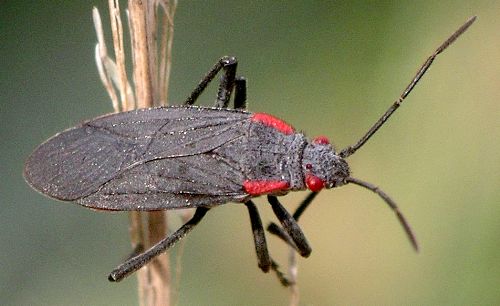by Valerie
March, 2014Red-shouldered Bug
It is not hard to determine the source of the colloquial name for the red-shouldered bug (Jadera haematoloma). This small true bug (order Hemiptera) is so common in the South that it has a second name in Florida, where it is known as the golden rain tree bug because of its association with that plant. Being a true bug, this insect feeds only on fluids, sucked in through its tube-like mouth. It mainly feeds on plants, with a strong preference for the exotic golden rain tree (Koelreuteria paniculata), as well as the native Balloon-vine (Cardiospermum halicacabum) and Mexican buckeye (Ungnadia speciosa). These plants all belong to the same family: Sapindaceae. Although this bug can be extraordinarily numerous at times, it rarely does much damage to plants and doesn't bother humans. Folks from the northern states will probably note its resemblance to the related box elder bug that frequently invades homes when seeking refuge before winter freezes arrive. The red-shouldered bug also gathers in large groups during cold weather, but it is more likely to be found in sheltered areas outside rather than in houses. Large overwintering groups will consist of normal adults, like the one shown above, short-winged adults, and nymphs, which have bright red bodies. The red-shouldered bug is a member of the family Rhopalidae, or scentless plant bugs. Most true bugs have scent glands, whether we notice their smell or not (think "stink bug"), but the rhopalids do not have these structures. This bug is considered a plant-feeder. Yet it is also an opportunistic scavenger and will readily suck liquid from dead insects. |